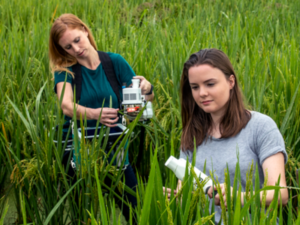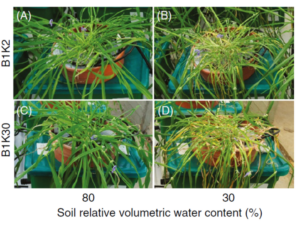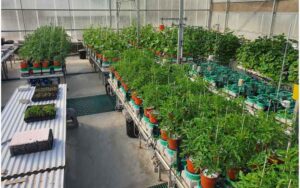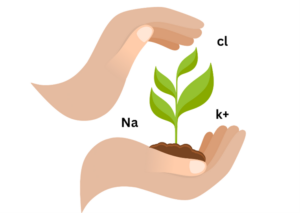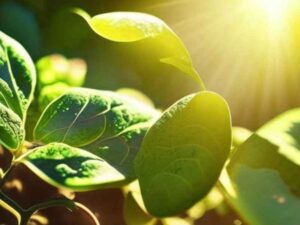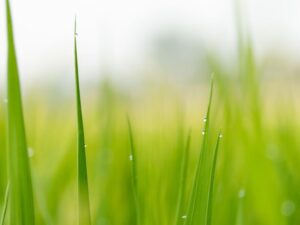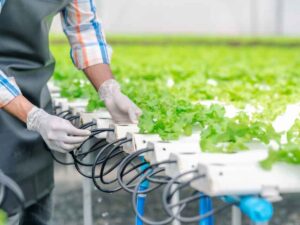Water efficient crops
The plant’s water cycle, also known as the “transpiration-cohesion-tension” or “capillary action” process, is a crucial mechanism that allows plants to transport water from the soil to various parts of the plant, including the leaves. This process involves several interconnected steps:
Root absorption:
Root Structure: Plant roots have a well-developed system of root hairs, which are tiny, finger-like projections that extend from the root’s surface. These root hairs significantly increase the root’s surface area, providing more contact points with the soil. The increased surface area enhances the plant’s ability to absorb water and nutrients from the surrounding soil.
Soil Water Availability: The rate of root absorption is influenced by the availability of water in the soil. If the soil has good water-holding capacity and is well-hydrated, the roots can absorb water more readily. However, in dry or water-deficient soils, the absorption rate may be slower, and the plant may need to extend its root system deeper into the soil to access water.
Cohesion and Adhesion
The movement of water up the xylem is facilitated by two main forces: cohesion and adhesion. Cohesion refers to the attraction between water molecules, causing them to stick together. Adhesion refers to the attraction between water molecules and the surfaces of the xylem cells. These forces together allow water to form a continuous column within the xylem, extending from the roots to the leaves.
Transpiration:
Transpiration is the process by which water vapor is lost from plants to the atmosphere through stomata—small openings on leaf surfaces that facilitate gas exchange. The transpiration helps in water and nutrient uptake as well as cooling the plant. Moreover, during transpiration, carbon dioxide (CO₂) is also taken in through these same open stomata for photosynthesis. The transpiration driving force is the Vapor Pressure Deficit (VPD), which is the difference in moisture between the inside of the leaf and the surrounding air.
Nutrient Transport: Transpiration not only transports water but also helps in the movement of essential nutrients and minerals absorbed by the roots. As water moves upward through the xylem, it carries these nutrients along with it, distributing them to different parts of the plant.
Cooling Mechanism: Transpiration plays a significant role in regulating the temperature of the plant. As water evaporates from the stomata, it releases latent heat energy, which cools down the leaf surface and the plant as a whole. This cooling effect is similar to how sweating helps cool down the human body.
Photosynthesis and Gas Exchange: Transpiration creates a continuous flow of water through the plant, enabling the transport of carbon dioxide (CO2) from the atmosphere into the leaf for photosynthesis. At the same time, oxygen produced during photosynthesis is released into the atmosphere through the stomata.
What affects plant water use efficiency?
Plant water use efficiency (WUE) refers to the amount of biomass produced per unit of water transpired by a plant. It is an important measure of a plant’s ability to utilize water efficiently, especially in water-limited environments. Several factors can affect plant water use efficiency:
Leaf anatomy and morphology: The structure and characteristics of leaves play a crucial role in WUE. Plants with smaller, thicker, and more succulent leaves generally have higher WUE as they reduce water loss through transpiration.
Photosynthetic pathway: Plants use different photosynthetic pathways, such as C3, C4, and CAM. C4 and CAM plants are generally more water-efficient than C3 plants, especially in hot and dry conditions.
Environmental factors: The availability of water, temperature, humidity, and light intensity all affect WUE. Plants grown in water-limited or drought-prone areas tend to have higher WUE as they adapt to conserve water.
Soil characteristics: The type and quality of soil can influence how efficiently plants can extract water from it. Well-drained soils with good water-holding capacity can enhance plant WUE.
Nutrient availability: Nutrient availability can impact WUE indirectly. For example, nutrient deficiencies may lead to stomatal dysfunction, affecting transpiration rates and subsequently WUE.
Plant age and stage of growth: The water use efficiency of a plant can vary depending on its growth stage. Young plants may have different WUE compared to mature ones.
Management practices: Agricultural practices, such as irrigation methods and fertilization, can affect plant water use efficiency. Proper irrigation scheduling and efficient water management can improve WUE.
Climate change: Altered climate patterns, such as increased temperatures and changing precipitation patterns, can influence WUE and may lead to shifts in plant species distribution.
Which are the most water-efficient crops:
Water-efficient crops, also known as drought-tolerant or drought-resistant crops, are those that can produce a reasonable yield with minimal water input. These crops have evolved various mechanisms to adapt to arid or water-limited environments. Here some of the most water-efficient crops include:
Cactus and succulents: These plants are well-adapted to arid conditions and can store water in their fleshy tissues, making them highly water-efficient.
Quinoa: Quinoa is a drought-tolerant crop that requires less water compared to many other grains.
Amaranth: Similar to quinoa, amaranth is a hardy crop that can withstand dry conditions.
Sweet potatoes: Sweet potatoes have a relatively low water requirement compared to other staple crops like potatoes.
Legumes (such as lentils, chickpeas, and beans): Legumes have nitrogen-fixing capabilities, which reduces their need for nitrogen-based fertilizers and can result in lower water usage.
Millet: Millet is a resilient grain crop that can thrive in semi-arid regions with limited water availability.
Sorghum: Sorghum is a drought-resistant grain crop commonly grown in dry areas.
Olive trees: Olive trees are well-suited to Mediterranean climates, which are often characterized by hot and dry summers.
It’s important to note that the water efficiency of crops can vary depending on factors such as climate, soil type, and agricultural practices.
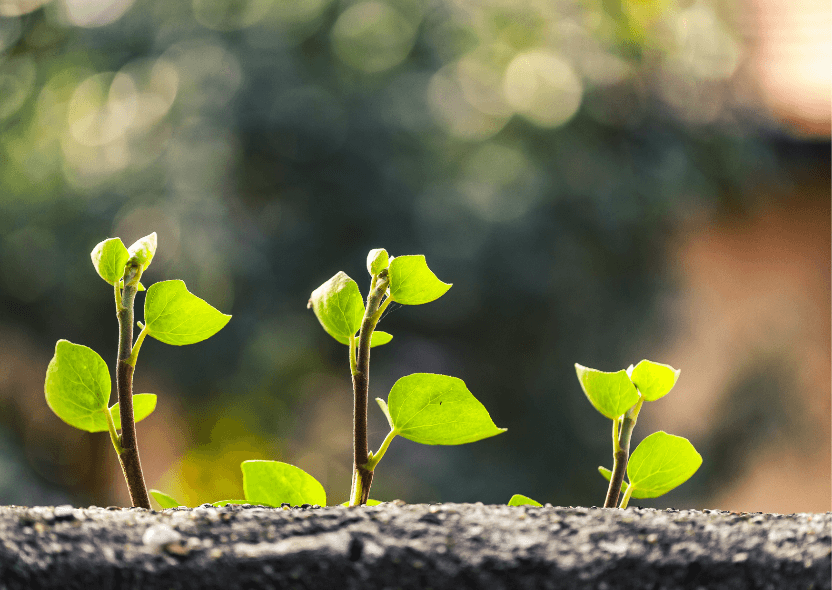
What methods the science use to increase plant water use efficiency?
Science employs various methods to increase plant water use efficiency (WUE), aiming to enhance crop productivity while minimizing water consumption. In this article we will present Some of the key approaches including:
Breeding and Genetic Improvement: Plant breeding programs focus on developing crop varieties with improved water use efficiency. This involves identifying and selecting plants with desirable traits, such as deep root systems, reduced stomatal conductance, and efficient water uptake mechanisms. By crossbreeding and genetic engineering, scientists can transfer these beneficial traits to commercial crops.
Molecular Studies: Studying the molecular mechanisms of drought tolerance and water use efficiency helps researchers understand the underlying processes and identify key regulatory genes. This knowledge can aid in the development of targeted strategies for improving water use efficiency.
Nanotechnology: Nanotechnology has shown promise in enhancing water use efficiency in plants. Nano-sized materials can be used to modify soil properties, improve water retention, and deliver water and nutrients to plant roots more effectively.
Root System Engineering: Developing plants with deeper and more extensive root systems allows them to access water from deeper soil layers. Research focuses on understanding root development and architecture to create crops with enhanced water uptake abilities.
Mulching: Applying organic or synthetic mulch around plants helps conserve soil moisture by reducing evaporation. Mulching also helps control weed growth, which competes with crops for water.
Improving Soil Structure and Health: Healthy soils with good structure can hold more water and provide better root penetration. Soil amendments and conservation practices like cover cropping and reduced tillage contribute to soil health and water retention.
Remote Sensing and Smart Technologies: Advanced technologies like remote sensing and data analytics allow for real-time monitoring of plant water status. This information helps optimize irrigation schedules, ensuring that water is supplied to crops when and where it is needed most.
Climate-Adaptive Farming Practices: Adapting agricultural practices to changing climate conditions can enhance water use efficiency. For example, adjusting planting dates, choosing drought-resistant crop varieties, and using climate-smart farming techniques can mitigate water stress risks.
It’s essential to emphasize that water use efficiency improvement should be context-specific, considering local climatic conditions, soil types, and crop characteristics. Additionally, sustainable water management practices and the adoption of these techniques by farmers are crucial to achieving long-term water use efficiency goals. Those are possible by using advanced technology such as our PlantArray system.
How does the regulation of stomatal behavior contribute to improved plant water use efficiency?
Stomata are small pores on the surface of leaves that play a crucial role in gas exchange and water vapor loss through transpiration. Proper regulation of stomatal behavior is essential for maintaining water balance in plants, especially under water-limited conditions. This topic explores the mechanisms behind stomatal regulation and how understanding and manipulating these processes can lead to improved plant water use efficiency.
Stomatal Control Mechanisms: The opening and closing of stomata are regulated by complex physiological and molecular mechanisms. The balance between two opposing forces, i.e., the accumulation of potassium ions (K+) in guard cells (promoting stomatal opening) and the loss of water (causing cell shrinkage and stomatal closure), determines stomatal aperture.
Role of Abscisic Acid (ABA): The phytohormone abscisic acid (ABA) is a key player in stomatal regulation. ABA levels increase in response to drought stress, triggering the closure of stomata to reduce water loss. Understanding the ABA signaling pathway and its interaction with other hormones and signaling molecules is critical for manipulating stomatal behavior under water-limiting conditions.
Role of Reactive Oxygen Species (ROS): Reactive oxygen species (ROS) are also involved in the regulation of stomatal behavior. ROS serve as signaling molecules, modulating the activity of ion channels and enzymes that affect the stomatal aperture. Studying ROS-mediated signaling pathways provides insights into the complex networks involved in stomatal control.
Natural Variation in Stomatal Traits: Different plant species and even different cultivars within a species may exhibit variation in stomatal traits. Identifying and understanding natural variations in stomatal regulation can help breeders select plants with better water use efficiency and drought tolerance.
High-Throughput Phenotyping Techniques: Advancements in high-throughput phenotyping technologies such as the PlantArray system allow researchers to rapidly assess stomatal traits in large populations of plants. These techniques facilitate the screening and identification of plants with superior water use efficiency, expediting breeding efforts.
In conclusion, the regulation of stomatal behavior is a vital physiological process that contributes significantly to improved plant water use efficiency. It allows plants to balance water loss with carbon dioxide uptake and nutrient uptake while responding to environmental signals, making them more resilient and adaptive to changing water availability.
How can the PlantArray system help researchers find the best water-efficient plant?
The PlantArray system by Plant-Ditech can help researchers find the best Plant Water Use Efficiency (WUE) by providing advanced tools for precise and high-throughput phenotyping of plants under various environmental conditions. Phenotyping is the process of quantifying plant traits, and in the context of WUE, it involves measuring parameters related to water uptake, water loss, and the overall water use efficiency of plants.
One of the key strengths of the PlantArray system is its high-throughput phenotyping capability. Researchers can analyze large populations of plants simultaneously, significantly reducing the time and effort required for data collection. This high-throughput approach allows for the screening of a diverse range of plant genotypes or treatments, enabling the identification of plants with superior water use efficiency.
The PlantArray system provides measurements of key physiological parameters related to water use efficiencies, such as stomatal conductance, transpiration rate, biomass, root influx, and more. These parameters offer valuable insights into how efficiently plants use water under different environmental conditions and stress levels.
In addition, Researchers can customize the experimental setup in the PlantArray system to mimic specific environmental conditions, such as varying levels of water availability or different levels of drought stress. This flexibility allows for the investigation of WUE responses across a wide range of scenarios, helping identify the most water-efficient plants under different stress conditions.
The PlantArray system comes equipped with automated data analysis software – the SPAC, which streamlines the processing and interpretation of the collected data. This software can generate comprehensive reports, graphs, and statistical analyses, making it easier for researchers to compare results and draw meaningful conclusions about plant water use efficiency.
At Plant-Ditech, we understand that every researcher has unique requirements. Whether you’re working in a research institute or a chemical company, our team of experts is dedicated to providing personalized assistance and expert advice. With our state-of-the-art automated phenotyping system and our software that analyzes the results, our PlantArray system is designed to optimize plant growth and elevate your research to new heights.
Join our growing community of satisfied customers and embrace the. Let Plant-Ditech be your trusted partner on this journey. For more details contact us today!

